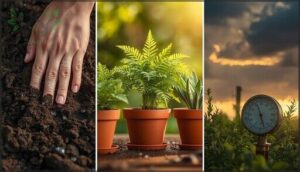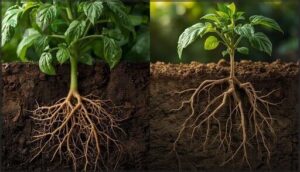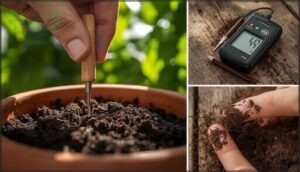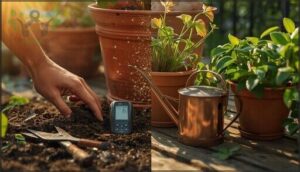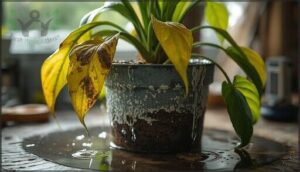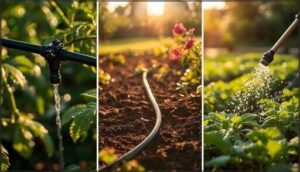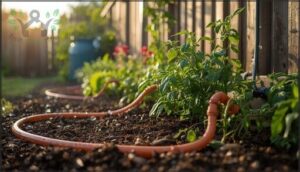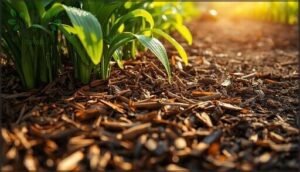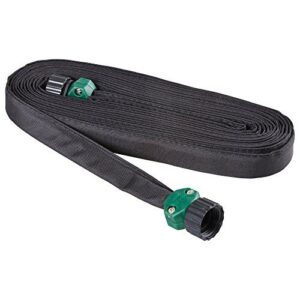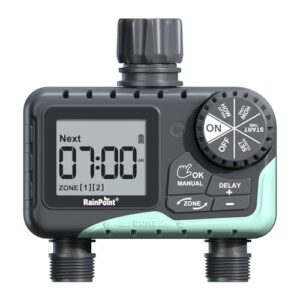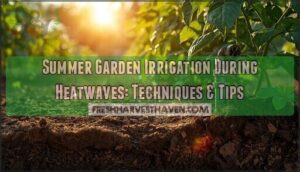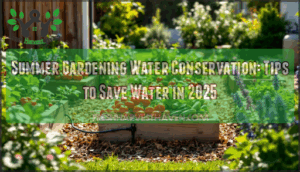This site is supported by our readers. We may earn a commission, at no cost to you, if you purchase through links.

Summer heat can turn a thriving garden into a wilted disaster in just a few days. The difference between lush, productive plants and stressed, struggling ones often comes down to one critical factor: how and when you water. Most gardeners water too often but not deeply enough, creating shallow roots that can’t handle heat stress.
Understanding the science behind watering plants in summer—from timing your sessions to reading your soil’s moisture levels—gives you the control to keep your garden healthy without wasting water. The right approach depends on your soil type, plant varieties, and local climate, but the core principles remain consistent.
Master these techniques, and you’ll spend less time worrying about your plants and more time enjoying them.
Table Of Contents
- Key Takeaways
- Best Times to Water Plants in Summer
- Factors Affecting Summer Watering Frequency
- Deep Watering Vs. Frequent Watering
- Measuring Soil Moisture Accurately
- Signs Your Plants Need Water
- Efficient Watering Techniques for Summer
- Conserving Water in The Summer Garden
- Role of Mulch in Summer Watering
- Adjusting Watering for Different Plants
- Top 5 Tools for Summer Plant Watering
- Frequently Asked Questions (FAQs)
- Conclusion
Key Takeaways
- Water early in the morning when root activity peaks and evaporation rates drop by up to 40%, allowing plants to absorb moisture efficiently before the day’s heat begins.
- Deep, infrequent watering builds root systems that reach 6 to 8 inches down where moisture lasts, while shallow watering creates weak roots confined to the top few inches where drought stress hits hardest.
- Drip irrigation and soaker hoses cut water waste by 60-70% compared to sprinklers by delivering moisture directly to root zones, making them the most efficient summer watering tools.
- A 2-3 inch layer of mulch reduces soil evaporation by up to 50% and keeps root zones cooler, letting you water less often while maintaining healthy plants through summer heat.
Best Times to Water Plants in Summer
When you water matters just as much as how much you water. The right timing reduces evaporation, prevents disease, and keeps your plants thriving through the hottest months.
Here’s what you need to know about scheduling your summer watering routine.
Early Morning Benefits
Early morning stands as the best time to water your summer garden. Root activity peaks before dawn, maximizing absorption right when photosynthesis begins. Cool temperatures improve soil retention and slash evaporation rates by up to 40% compared to midday watering. Effective watering at this time also helps prevent fungal diseases.
- Plants absorb water most efficiently when roots are most active at dawn
- Leaves dry quickly during daylight, preventing fungal infections and disease prevention
- Lower temperatures and calm winds reduce water waste through evaporation
- Pest deterrence improves as moisture-loving insects avoid drier daytime conditions
- Morning watering aligns perfectly with your plants’ natural metabolic cycles
Late Afternoon or Early Evening Option
If early morning doesn’t fit your watering schedule, late afternoon offers a solid alternative. You can slash evaporation losses to just 1.5–3% by watering after the day’s heat peaks. Deeper penetration happens as cooler temperatures slow water loss, building root resilience through consistent overnight moisture.
Using drip irrigation can help you avoid potential foliar diseases. Just finish at least one to two hours before sunset—this ensures foliar drying and prevents fungal issues, especially in humid summer climates.
Why Avoid Midday Watering
Watering at midday in summer wastes water through rapid evaporation—up to 30% lost before reaching roots. High temperatures force stomata closure, reducing absorption by 10–30%.
Wet foliage under intense sun invites foliar disease, while sudden soil cooling can trigger root shock.
You’ll use 30% more water seasonally with midday techniques, straining both your garden and local supplies.
Factors Affecting Summer Watering Frequency
How often you water in summer isn’t just about the calendar. Your soil, your plants, and your local weather all play a role in determining what your garden actually needs.
Let’s look at the three main factors that shape your watering schedule.
Soil Type and Drainage
Your soil type dictates how you water. Sandy soil drains fast, losing moisture quickly and demanding frequent watering. Clay soil holds water longer but drains poorly, risking root suffocation without proper drainage systems. Loamy soil offers ideal loam retention and soil structure, balancing moisture availability with drainage.
Check soil moisture regularly, and adjust your watering schedule based on your specific soil’s behavior to maintain healthy plants.
Plant Type and Maturity
Different plant species demand unique watering rhythms. Annuals with shallow roots need daily water during heat, while perennials require watering just two to three times weekly. Mature trees access deep moisture, requiring watering every two weeks.
Container plants dry out faster than ground plantings, often needing twice-daily attention.
New plantings need frequent irrigation—four to six times weekly—until roots establish.
Local Climate Considerations
Your region’s climate fundamentally shapes your watering schedule. In hot, dry areas with winds, you’ll need to water more frequently as evaporation rates skyrocket. When temperatures hit 90°F (32°C), double your watering frequency from one inch weekly to two inches.
Humid zones need less irrigation since moisture lingers longer. Regional water needs shift with seasons, so adjust your routine as heat patterns change.
Deep Watering Vs. Frequent Watering
How you water matters just as much as when you water. Deep, infrequent watering builds stronger plants than light, daily sprinkling ever will.
Let’s look at why deep watering wins, what shallow watering costs you, and how to actually do it right.
Encouraging Strong Root Growth
Think of root systems as anchors—the deeper they go, the better your plant withstands heat and drought. Deep watering pushes roots downward, often reaching 6 to 8 inches or more, where soil moisture stays reliable. Research shows root length can increase over 300% under controlled irrigation. This method improves nutrient absorption, drought resistance, and overall plant health.
Deep watering drives roots 6 to 8 inches down where moisture lasts, boosting drought resistance and nutrient uptake by over 300%
| Watering Method | Impact on Root Depth |
|---|---|
| Deep, infrequent watering | Encourages roots to grow 12-18 inches deep |
| Drip irrigation | Delivers water directly to root zones |
| Soaker hoses | Promotes steady downward root growth |
| Morning watering | Reduces evaporation, maximizes root uptake |
| Mulching combined with deep watering | Minimizes soil compaction, retains moisture |
Risks of Shallow Watering
Shallow watering keeps roots near the surface, where soil moisture fluctuates quickly and nutrients become scarce. Your plants become vulnerable to drought, with survival rates dropping by 40-60% when heat strikes. Disease susceptibility climbs, fungal issues increase up to 40%, and water waste reaches 55% through evaporation. Root development suffers dramatically—systems stay 38% shorter, limiting nutrient uptake by 35% and amplifying plant stress when underwatering occurs.
| Risk Category | Impact | Prevention |
|---|---|---|
| Root Development | Roots stay 38% shorter, confined to top 5-10 cm | Water deeply to encourage downward growth |
| Drought Vulnerability | 40-60% lower survival during dry spells | Build resilient root systems with infrequent, deep watering |
| Disease Susceptibility | Fungal diseases increase 30-50% | Keep foliage dry, water at soil level |
| Nutrient Deficiency | Uptake reduced by up to 35% | Deep watering accesses nutrient-rich lower soil layers |
How to Water Deeply
Deep watering transforms your plants into drought warriors by pushing moisture 8 inches down, right where root systems thrive. Apply water slowly at the plant base, wait 30 minutes for percolation, then check soil saturation level with a trowel. Adjust your watering technique based on soil type—sandy ground needs less, clay demands more.
| Soil Type | Water Needed for 5-6 Inch Depth |
|---|---|
| Sandy | 1/2 inch |
| Loam | 3/4 inch |
| Clay | 1 inch |
| Deep-Rooted Vegetables | Water to 24-36 inches |
| Standard Garden Plants | Target 8-inch root zone depth |
This approach delivers real conservation outcomes—you’ll water less often while your plants access moisture reserves that last for days.
Measuring Soil Moisture Accurately
Knowing when to water starts with understanding what’s happening beneath the surface. You can’t always trust the top layer of soil, since moisture levels vary at different depths where roots actually feed.
Here are three reliable ways to check soil moisture before you turn on the hose.
Finger Test Method
You don’t need fancy gadgets to check soil moisture—your finger does the job. Insert it up to the second knuckle near your plants, then assess:
- Morning checks are best: Test early or late afternoon, never during midday heat
- Soil texture affects accuracy: Loamy garden soils provide clearer feedback than sandy types
- Depth matters for truth: Surface dryness after rainfall can mislead; probe deeper
- Pair with other watering techniques: Combine with visual plant checks during summer
- Experience improves results: Tool integration helps sharpen your instincts over time
Using Soil Moisture Meters
While your finger gives you a decent read, a soil moisture meter takes guesswork off the table. These sensors measure volumetric water content with accuracy around ±3 to 4% for most garden soils, sharpening your summer watering decisions. Calibration boosts precision to ±1 to 2%, making irrigation thresholds clearer and helping you avoid overwatering or drought stress.
Practical insights show growers delay watering based on sensor data, conserving water while promoting healthier roots—essential during peak summer months when demand skyrockets.
| Feature | Basic Meters | Calibrated Sensors |
|---|---|---|
| Accuracy Range | ±3-4% VWC | ±1-2% VWC |
| Cost Investment | Low ($10-30) | Moderate-High ($50-200+) |
| Sensor Type | Resistance-based | TDR/Capacitance |
| Irrigation Decisions | General guidance | Precise thresholds |
| Market Growth Driver | Home gardening rise | Precision agriculture demand |
Best Times to Check Soil Moisture
Morning moisture peaks occur between 5 a.m. and 9 a.m., when evaporation sits at its daily low and dew absorption effects are still measurable. Checking soil moisture levels during these hours cuts water use by up to 30% compared to midday monitoring.
Avoid afternoon evaporation rates and peak heat—soil temperature impact skews readings, and you’ll overestimate your plants’ actual needs.
Signs Your Plants Need Water
Your plants will tell you when they’re thirsty if you know what to look for. Learning to read these signals helps you water at the right time, not too early or too late.
Watch for these common signs that indicate your plants need attention.
Visual Signs of Underwatering
Your plants often speak before they wilt, showing stress through yellowing leaves and crispy edges that brown and curl. These visual cues signal drought conditions impacting summer growth.
Stunted development, dry cracked soil, and leaf drooping all point to inadequate watering. When foliage fades or rolls inward, you’re witnessing your plants conserve what little moisture remains, a survival response demanding immediate attention.
Checking Soil and Plant Wilting
Beyond visual inspection, you need hands-on soil assessment to confirm wilting causes. Press your finger two inches down for potted plants, six inches for in-ground beds. Dry soil at these threshold levels signals immediate watering needs.
Moisture meters offer precise readings, helping you avoid guesswork in summer garden care. When soil feels dusty and plant health declines, don’t wait—your inspection reveals exactly when watering becomes critical.
Monitoring for Overwatering Symptoms
While underwatering gets most attention, overwatering creates equally serious problems through root oxygen deprivation and stunted shoot growth. Your summer plants show distinct symptoms when soil moisture stays too high:
- Leaves turn yellow or brown but feel limp, not crisp
- Soil fungal growth or mold appears on the surface
- Leaf discoloration includes blistering or warty patches
- Reduced flower production despite healthy-looking foliage
- Musty smell indicates root rot or fungal disease
Check soil before watering—constant wetness invites plant diseases you can’t easily reverse.
Efficient Watering Techniques for Summer
Watering efficiently during summer means choosing the right method for your garden’s size and layout. The right tool can cut down on waste, save you time, and make sure your plants get moisture exactly where they need it.
Here are three proven techniques that work well in the heat.
Drip Irrigation Systems
If you want efficiency, a drip irrigation system delivers water directly to plant roots with minimal waste. These irrigation systems operate at low water pressure, around 10-20 psi, cutting water use by up to 60 percent.
System installation is straightforward, and you can integrate fertigation for precise nutrient delivery.
Component selection matters—choose quality tubing and emitters. Regular maintenance tips include checking for clogs and adjusting flow rates as plants grow.
Soaker Hoses for Consistent Moisture
For consistent moisture delivery, a soaker hose weeps water slowly through porous material, saturating soil evenly along its length. You’ll reduce water use by up to 70 percent compared to sprinklers.
Lay the hose near plant roots, then cover it with mulch to boost retention. Keep water pressure low, around 10 to 25 psi, to prevent uneven distribution and minimize clogging issues.
Using Watering Wands and Cans
For precision watering, a watering wand extends your reach to hanging baskets and tall plants, while a watering can offers portability for containers.
Wands deliver a gentle, rain-like spray at 10 to 48 inches, reducing foliage disease risk. Cans holding up to 2.6 gallons suit smaller spaces.
Direct both tools at plant bases, avoiding leaves, and rinse after fertilizer use to prevent clogs.
Conserving Water in The Summer Garden
Every drop counts when summer heat peaks and your water bill climbs. You can cut waste without sacrificing a healthy garden by making a few smart adjustments to your routine.
Below are three practical strategies that help you conserve water while keeping your plants thriving.
Mulching to Retain Moisture
Mulch acts like a protective blanket over your soil, cutting evaporation by up to 50% during hot summer months. Apply a 2-3 inch layer of organic mulch types like shredded bark or straw around your plants.
This application depth keeps soil temperature cooler, blocks weeds competing for moisture, and gradually enriches soil as it breaks down—meaning you’ll water less while your garden thrives.
Recycling Household Water
Greywater systems transform kitchen and shower runoff into a free water source, cutting residential consumption by 25-45% while keeping your garden lush. You can save over 18,000 gallons yearly, but water quality matters for crop safety.
Use recycled household water on ornamentals first, test soil moisture regularly, and apply these watering techniques:
- Filter sediment before distributing water
- Dilute greywater with fresh water periodically
- Avoid watering edible crops directly with untreated water
- Monitor plants for salt accumulation signs
- Rotate application zones to prevent buildup
Setting Up Automatic Water Timers
Beyond manual recycling, automatic timers turn irrigation systems into efficient watering machines. You’ll slash water bills by 15-40% with digital models that adjust your watering schedule based on soil moisture, not guesswork.
Timer type selection matters—choose WiFi-enabled versions for remote access benefits or mechanical units for simplicity. Installation best practices include attaching directly to outdoor faucets, programming drip irrigation system zones separately, and matching watering frequency to plant needs. Maintenance requirements include battery checks and sensor cleaning.
| Timer Feature | Water Savings Impact |
|---|---|
| Rain delay function | Prevents unnecessary watering after storms |
| Soil moisture sensors | Adjusts irrigation automatically, reducing waste by 30% |
| Multiple zone control | Customizes watering frequency per plant type |
Role of Mulch in Summer Watering
Mulch acts like a protective blanket for your soil, keeping moisture locked in and roots cool when the heat cranks up. The type you choose and how you apply it can make or break your summer watering strategy.
Here’s what you need to know to use mulch effectively in your garden.
Organic Vs. Inorganic Mulch
Your choice between organic and inorganic mulch shapes your garden’s future. Organic options like bark decompose steadily, feeding soil nutrients while maintaining moisture and regulating temperature swings by up to 5%.
Inorganic materials—stones or plastic—excel at weed suppression and last multiple seasons without replacement, but they won’t enrich your soil.
Consider your summer watering goals and garden maintenance schedule when deciding.
Proper Mulch Application Depth
After picking your mulch type, getting the depth right matters more than you might think. Aim for 2 to 3 inches around flower beds and 3 to 4 inches near trees and shrubs to lock in soil moisture without suffocating roots.
Avoid piling mulch against stems—leave a few inches clear to prevent rot and pest issues during hot summer months when watering interactions become critical for plant health.
Preventing Soil Temperature Fluctuations
Mulch does more than hold soil moisture—it acts as a thermal blanket that keeps root zones from swinging between scorching days and cool nights.
A 2- to 4-inch layer cuts temperature extremes by over half, protecting roots from heat stress. Pair it with early morning irrigation to drop soil temps by up to 10°F, giving your plants stable conditions they need to thrive.
Adjusting Watering for Different Plants
Not all plants drink at the same pace, and treating them as if they do is one of the quickest ways to run into trouble. Vegetables have different needs than ornamentals, container plants dry out faster than ground beds, and drought-tolerant species play by their own rules entirely.
Here’s how to adjust your watering approach based on what you’re growing.
Watering Vegetables Vs. Ornamentals
Vegetables and ornamentals have distinctly different water needs during summer. Vegetables generally require 1 to 2 inches weekly, with shallow-rooted varieties like lettuce needing near-daily watering. Root vegetables demand consistent soil retention to prevent cracking.
Ornamentals, especially established perennials, need deep watering every 1-2 weeks. Watch for stress signs: vegetables wilt quickly, while ornamentals show gradual browning.
Drip irrigation improves water efficiency for both.
Caring for Container Plants
Container plants demand extra attention in summer. Daily watering is often necessary when temperatures exceed 77°F, as limited soil volume dries faster than garden beds. Here’s what you need to know:
- Check soil moisture daily using your finger or a meter
- Water thoroughly until drainage appears at the pot bottom
- Consider self-watering pots to maintain consistent moisture
- Rotate containers weekly for uniform hydration
- Use a watering can with a long spout to target roots directly
Container size and soil composition directly affect drainage needs and watering frequency.
Drought-Tolerant Plant Strategies
Although drought-resistant plants conserve water once established, they need consistent watering during their first summer—sometimes every other day—to develop deep root adaptations. By the second year, reduce frequency to biweekly, ensuring soil moisture penetrates 18 inches deep.
Established plants generally need watering only monthly, unless rainfall falls short. This approach builds drought resilience and promotes successful plant establishment while supporting effective drought management throughout summer.
Top 5 Tools for Summer Plant Watering
The right tools can make summer watering easier and more effective. You don’t need a complicated setup, just equipment that delivers water where your plants need it most.
Here are five tools that help you water efficiently while conserving time and resources.
1. Dramm One Touch Rain Wand Green
The Dramm One Touch Rain Wand Green delivers a gentle spray that protects delicate plants from soil erosion and root exposure. Its thumb control valve lets you adjust water flow with one hand, reducing fatigue during long watering sessions.
The aluminum build keeps the wand lightweight yet durable, and user feedback consistently praises its reliability over years of use.
By targeting roots precisely, this watering wand aids water conservation and makes watering plants more efficient than standard watering cans or less controlled watering techniques.
Best For: Gardeners who need precise water control for delicate plants, hanging baskets, or raised beds and want a durable wand that reduces hand fatigue during long watering sessions.
- One-touch thumb valve gives you complete flow control with one hand, so you can water for extended periods without straining your grip.
- Lightweight aluminum construction with rubber overmold makes it easy to maneuver while staying durable enough for years of daily use.
- Gentle rain-like spray protects delicate plants and prevents soil erosion, making it ideal for seedlings, flowers, and hanging baskets.
- Requires adequate water pressure (around 30-90 PSI) to work properly—low pressure systems may experience reduced performance or dripping.
- Some users report durability issues with the plastic shut-off valve or nozzle head cracking after extended use.
- The 16-inch length may feel too short for reaching hanging baskets or tall plants, requiring you to purchase the longer 30-inch model separately.
2. Melnor 50 ft Flat Soaker Hose
The Melnor 50 ft Flat Soaker Hose delivers water directly to plant roots, making it a smart choice for summer irrigation. Its flat, porous design seeps moisture slowly along its entire length, reducing runoff and evaporation during hot weather.
You can place it above ground or tuck it under mulch for better water conservation benefits. The hose flattens for compact storage and comes with a 2-year limited warranty.
Customer satisfaction insights reveal strong performance in raised beds and vegetable rows, though some users report occasional leaks after extended use.
Best For: Gardeners looking for a water-efficient way to keep vegetable beds, shrubs, and raised gardens hydrated during summer without wasting water through runoff or evaporation.
- Delivers slow, targeted watering directly to plant roots, minimizing water waste and evaporation during hot weather.
- Flat design makes it easy to store compactly and flexible enough to place above ground or hide under mulch.
- Comes with a rust-resistant end cap so you can connect multiple hoses and extend coverage across larger garden areas.
- Some users report uneven water distribution along the full 50-foot length, requiring careful positioning.
- Durability is inconsistent—while some customers get years of use, others experience leaks or cracking at the hose ends.
- Not ideal for high-traffic areas or gardens with critters, as the hose can be easily damaged.
3. Coolaroo Wheat Shade Fabric Privacy Screen
Shade can cut your summer watering workload by reducing soil moisture loss. The Coolaroo Wheat Shade Fabric Privacy Screen blocks 90% of harmful UV rays while lowering temperatures underneath by up to 32%, which directly improves water conservation.
Its breathable HDPE material allows airflow, preventing heat buildup that stresses plants. You can install it over patios, pergolas, or garden beds in under 30 minutes.
Durability testing confirms 15-year UV protection, and environmental safety certifications make it safe around edible plants and pets.
Best For: Gardeners and homeowners looking to reduce watering frequency while protecting outdoor spaces from intense sun and heat.
- Blocks 90% of UV rays and lowers temperatures by up to 32%, which cuts down on soil evaporation and helps plants retain moisture longer between waterings.
- Breathable fabric allows air to flow through, preventing the stuffy heat buildup you’d get with solid covers while still providing solid shade and privacy.
- Backed by a 15-year warranty against UV damage and made from recyclable, pet-safe material that holds up through years of sun and weather exposure.
- Edges can come unfinished and uneven, so you’ll need to trim and secure them yourself to get a clean look and prevent fraying.
- The fabric arrives stiff and may need weights or extra tie-downs in windy areas since it can catch gusts and shift around if not anchored well.
- Some buyers report the color doesn’t always match what’s shown online, and wrinkles from shipping can be stubborn to smooth out even after installation.
4. RAINPOINT Two Zone Water Timer
If you need more control over your summer irrigation, you’ll appreciate the RAINPOINT Two Zone Water Timer. It lets you program up to six watering schedules per zone, each running from 1 minute to 12 hours. You can customize daily, weekly, or interval-based cycles to match different plant needs.
The WiFi-enabled version allows remote control and tracks water usage with less than 7% error. System expansion accommodates up to eight zones through one app, making this timer adaptable as your garden grows.
Best For: Homeowners managing multiple garden areas with different watering needs who want precision scheduling and the option for remote monitoring.
- Six independent schedules per zone with flexible durations (1 minute to 12 hours) let you fine-tune watering for different plant types and soil conditions.
- Built-in water flow meter tracks usage with high accuracy, helping you spot leaks early and understand your actual consumption patterns.
- WiFi model integrates with Alexa and Google Assistant for voice control, plus expands to manage up to eight zones through one convenient app.
- Battery-powered operation means you’ll need to swap out AA or AAA batteries periodically, especially during heavy watering seasons.
- No WiFi connectivity on the basic model limits remote access and smart features that many users now expect from irrigation controllers.
- Some users report durability issues after one season of outdoor use, and the screen can blank out in direct sunlight.
5. Automatic Plant Waterer Drip Irrigation Kit
For gardeners managing 15 or more potted plants, the Automatic Plant Waterer Drip Irrigation Kit offers hands-off watering through smart humidity detection and programmable timers.
Kit components include tubes, T-joints, droppers, and filters for customizable setup. System capacity accommodates small container gardens up to larger plantings, with adjustable flow rates matching different plant sizes.
Drip irrigation can reduce water consumption by 60% to 90% compared to traditional watering techniques. Installation costs range from $15 to $480, depending on coverage area and automation features, making water conservation accessible for various budgets.
Best For: Busy plant owners or frequent travelers who need automated care for 15 or more potted plants without daily monitoring.
- Saves 60% to 90% of water compared to traditional watering methods by delivering moisture directly to roots with minimal evaporation.
- Programmable timer and humidity detection adjust watering automatically, reducing the risk of overwatering or underwatering your plants.
- Affordable DIY setup starting around $15 to $480 with all necessary components included for quick installation.
- Humidity sensor can be unreliable in certain environments, with no option to adjust sensitivity settings.
- Requires trial and error to find the right watering duration and amount for each plant type.
- Water supply limitations may need longer run times to adequately hydrate all plants in the system.
Frequently Asked Questions (FAQs)
How does humidity affect summer watering needs?
In coastal Tampa, high humidity slows transpiration rates and soil evaporation, letting you water less often.
Drier Phoenix demands daily watering adjustments because rapid evaporation rates increase plant stress and watering frequency needs substantially.
Should I water differently during heatwaves?
Yes, you should adjust your watering schedule during extreme summer heat. Increase watering frequency and deep soak early morning or evening to reduce evaporation rates.
Monitor soil temperature impact on plant physiology and heat stress.
Can I water plants with greywater safely?
Greywater contains surfactants and salts that can harm plants. You can safely use it diluted—mix one part greywater with three parts tap water—and apply directly to soil, avoiding edible crops and foliage entirely.
Whats the best water temperature for plants?
The ideal water temperature sits between 65°F and 70°F, mimicking natural rainfall.
Cold water below 60°F can shock roots, while temperatures above 75°F reduce oxygen solubility and encourage harmful root pathogens.
How do I revive severely dehydrated plants?
When your plant looks like it’s given up the ghost, there’s hope. Slowly soak the root zone until water drains freely.
Monitor moisture levels closely, avoiding root rot while supporting physiological stress recovery and damage repair.
Conclusion
A gardener in Phoenix switched from quick daily sprinkles to deep watering three times weekly. Within two weeks, her tomatoes rebounded, their roots reaching eight inches down instead of hovering near the surface. That’s the power of informed strategy.
Watering plants in summer isn’t about spending more time with a hose—it’s about working smarter. Apply these principles consistently, and your garden will prove resilient when the next heat wave hits.
- https://www.epa.gov/watersense/when-its-hot
- https://www.scwa.com/assets/1/6/peak2011_facts-tips.pdf
- https://extension.psu.edu/watering-to-beat-the-summer-heat/
- https://ucanr.edu/blog/garden-notes/article/how-much-water-do-my-plants-need-summer
- https://ashcombe.com/watering-101-how-much-and-how-often-to-water-plants/

